Telehealth Reverse Diabetes With Regular Exercise Testing | Free Trial In Texas

Don’t just guess — measure. How strong are you? How far can you walk?
Keep records that document progress. So you can see what’s working.
To learn more about the programs Herd Healthcare offers, our website is:
www.herdhealthcare.com
Steady State Assessment
Measure everything a couple of times. You need to know for sure what your physical condition is right now.
Check with your personal physician that strength and endurance training is a good idea. Take an Exercise Tolerance Test if there’s any question about safety. Define any handicaps and work within safe limits.
Check results of laboratory tests. In particular check results of renal blood laboratory tests. Are there any doubts about safety of increasing your daily intake of protein to about 150 grams a day?
Baseline Measurements
Equipment needed:
•Notebook (for on-the-spot records and reports)
•Mobile Smartphone or Tablet (for transmission and permanent records)
•Clock or Stopwatch (measure minutes and seconds)
•Bathroom Scales (measure one tenth pounds)
•Solid measuring ruler (measure standing and sitting inches)

•Cloth measuring tape (measure inches around waist, hips, thighs)
•Blood Pressure Measurement Device (mm Hg)
•Heart Rate Counter (or count your pulse for 15 seconds and multiply x 4)
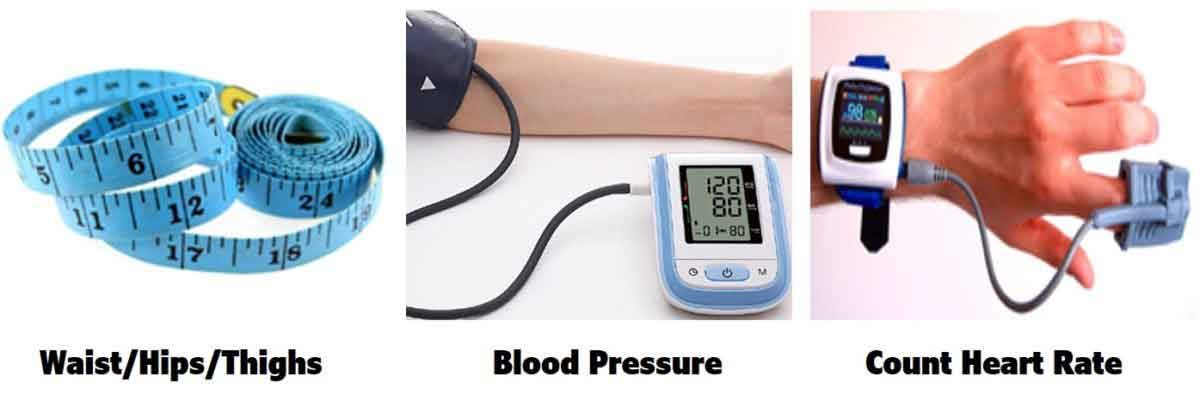
•Oral Thermometer (measure one tenth degrees Fahrenheit)
•Glucometer (measure mg/dL)
•Pedometer (calibrate inches and pounds, report steps and miles)
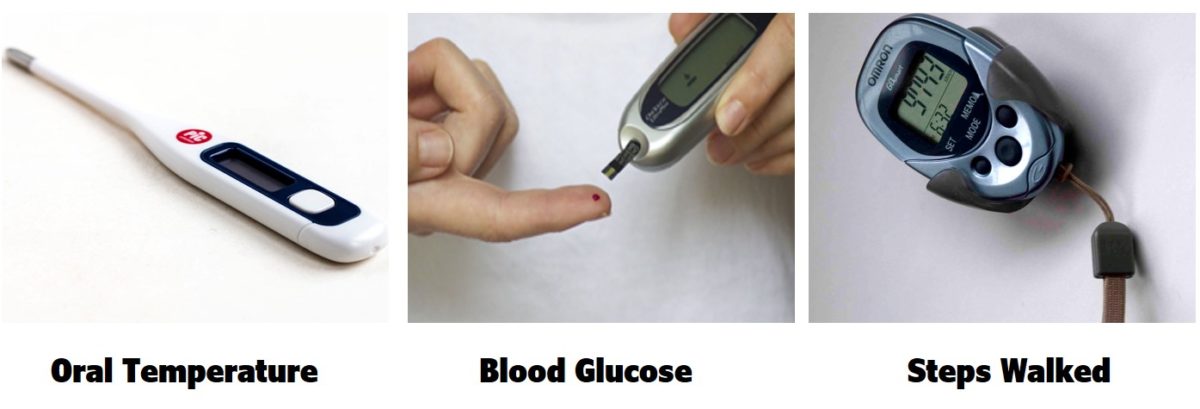
Nutrition using on-line resources:
•Total Calories (kcal/day)
•Carbohydrates, Proteins, Fats (grams/day)
•Sodium, Potassium, Sugar
Medications:
•Diabetes
•Blood Pressure
•Cholesterol and Lipid Disorders
Physical Measurements:
•Height (standing and sitting)
•Body weight (fasting in the morning)
•Blood sugar (fasting in the morning)
•Blood pressure (fasting in the morning)
•Heart rate twice (fasting in the morning and late evening)
•Oral temperature twice (fasting in the morning and late evening)
•Body circumferences (maximums around Waist, Hips, Thighs)
Baseline Exercise Tests
Walking Tolerance Test:
The test should be done at a time of day when repeat tests can be done and in a place that can be used again.
If the test is being done outdoors, the place to walk should be flat and unobstructed. Ambient temperature should be no more than 80° F and no less than 50° F.
If the test is being done inside, the area should have an unobstructed hallway that is at least 100 feet long or a wide circular track at least 50 feet in diameter. Room temperature should be no more than 80° F and no less than 50° F.
You should be dressed in comfortable clothing and wear shoes designed for walking. If you need an aid for walking such as a cane or a walker you should use it during the test.
Rest, sitting in a chair for at least 10 minutes before you start the Walking Tolerance Test.
Set your stopwatch and your pedometer to zero before you start. If your timer or your pedometer does not have a reset option, note the time or note the number of steps already displayed when you start.
Measure and record your heart rate just before you start walking. If you do not have a heart rate counter, find the artery on the thumb side of your wrist and count the number of pulses you can feel for 15 seconds. Multiply that number times 4 to calculate the pulse rate in one minute.
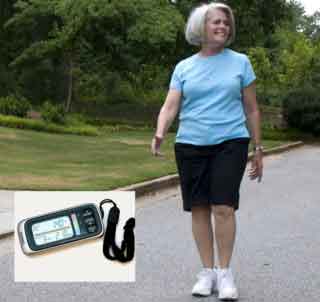 During the test, you should walk as fast as you can at a pace you expect you can keep up for 6 minutes. Do not jog or run. While walking, you can slow down and even stop to rest if that’s necessary. If you do stop to rest, resume walking as soon as you can.
During the test, you should walk as fast as you can at a pace you expect you can keep up for 6 minutes. Do not jog or run. While walking, you can slow down and even stop to rest if that’s necessary. If you do stop to rest, resume walking as soon as you can.
Start your Stopwatch or Read the time on your timepiece and Start Walking.
Stop walking 6 minutes after you start the walking tolerance test and record your heart rate. Note the number of steps displayed on the pedometer as soon as possible after you stop walking.
Record Heart Rate Before and After the 6-minute Walking Tolerance Test and Record Total Pedometer Steps.
Strength Tolerance Tests:
These tests should be done at a time of day when repeat tests can be done and in a place that can be used again.
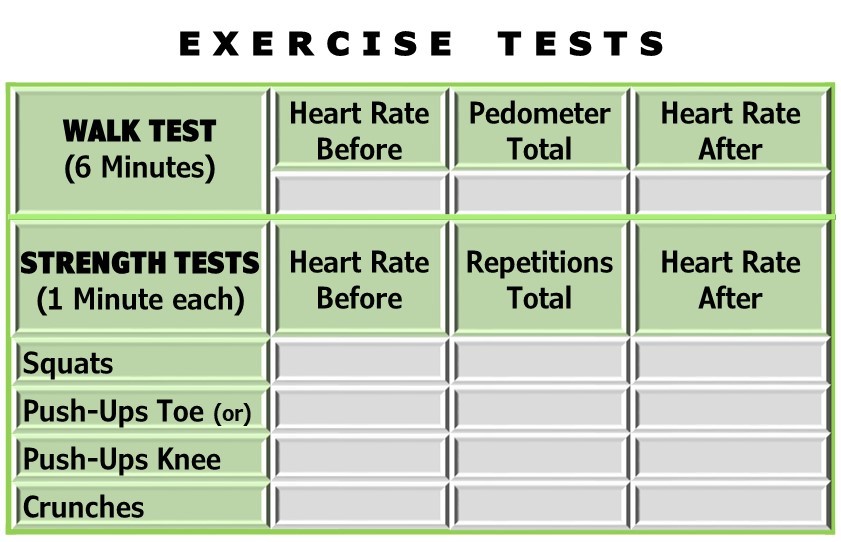
Air temperature should be no more than 80° F and no less than 50° F.
You should be dressed in comfortable clothing and wear athletic shoes.
Rest, sitting in a chair for at least 10 minutes before you start the Strength Tolerance Tests. Each Strength Test takes a least 1 minute to perform and you should rest at least 4 minutes between each test.
Set your stopwatch to zero before you start each test. If your timer does not have a reset option, note the time displayed when you start each test.
Measure and record your heart rate just before you start each test. If you do not have a heart rate counter, find the artery on the thumb side of your wrist and count the number of pulses you can feel for 15 seconds. Multiply that number times 4 to calculate the pulse rate in one minute.
You should perform each repetition at a rate you expect you can keep up for 1 minute. During each test, you can slow down and even stop to rest if that’s necessary. If you do stop to rest, resume repetitions as soon as you can.
Start your Stopwatch or Read your timepiece and Start Repetitions.
Stop repetitions 1 minute after you start and measure your heart rate.
Record Heart Rate Before and After each Strength Test and Record the number of Repetitions.
•Squat Test:
Use a chair with a flat solid seat at a height from the floor you can sit on with your thighs parallel to the floor.
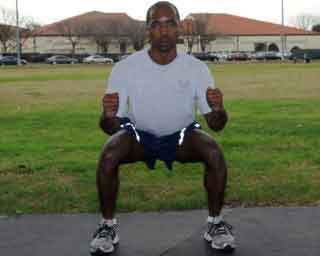 Stand in front of the chair, facing away from it, with your feet shoulder-wide apart. Squat down until your rear end just slightly touches the chair. Your knees should be bent at about a right angle. Keep your back straight, hold your arms straight at an angle in front of you and look straight ahead.
Stand in front of the chair, facing away from it, with your feet shoulder-wide apart. Squat down until your rear end just slightly touches the chair. Your knees should be bent at about a right angle. Keep your back straight, hold your arms straight at an angle in front of you and look straight ahead.
Take about a minute for warm up stretching or do a few trial squats. Then rest 2 or 3 minutes before actually starting the Squat Test.
•Push-Up Test:
Lie face-down on a mat or the floor. Decide whether you will extend your body with your knees on the floor or your toes on the floor. Record the option you choose on the Push-Up Test Report Form.
Place your hands wider than shoulder-wide apart, knees and feet slightly apart 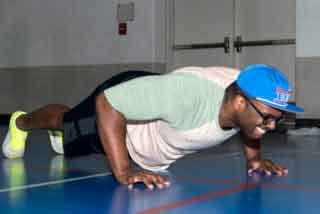 and keep your body straight from shoulders to knees or toes.
and keep your body straight from shoulders to knees or toes.
Lower your body until your elbows are bent at about a right angle. Straighten your arms and raise your body until they’re almost straight and repeat.
Take about a minute for warm up stretching or do a few trial push-ups. Then rest 2 or 3 minutes before actually starting the Push-Up Test.
•Crunch Test:
Lie on your back on a mat or the floor.
Cross your arms on your chest or place your hands behind your neck and bend your knees at about a right angle with your heels on the floor.
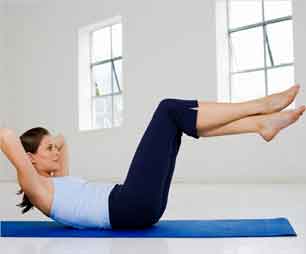 Tighten your abdominal muscles to lift your shoulders and your feet. Raise your shoulders until your shoulder blades are an inch or two off the floor. Raise your legs until your heels are about 6 inches off the floor. Hold your neck straight and keep looking up. Relax and repeat.
Tighten your abdominal muscles to lift your shoulders and your feet. Raise your shoulders until your shoulder blades are an inch or two off the floor. Raise your legs until your heels are about 6 inches off the floor. Hold your neck straight and keep looking up. Relax and repeat.
Breathe out while flexing up and breathe in while relaxing down.
Take about a minute for warm up stretching or do a few trial crunches. Then rest 2 or 3 minutes before actually starting the Crunch Test.
Repeat Exercise Sessions
To Reverse Diabetes, Resistance Strength Exercise sessions of 30 minutes should be done 3 times each week. Endurance Aerobic Exercise sessions of 30 minutes should be done 5 times each week.
Repeat Exercise Testing
To assess progress, Exercise Tolerance Testing should be repeated every 2 weeks.
Summary
Exercise Tolerance Testing is the best way to measure progress using exercise to Reverse Diabetes. Caloric Restriction and Endurance Exercise reduce body weight which reduces insulin resistance. Increasing Skeletal Muscle Strength increases insulin sensitivity. Improvement in exercise endurance and muscle strength demonstrates progress even when body weight has not gone down.
Measure Muscle Strength and Endurance every two weeks. It’s not enough to simply “do your best.” Do what improves results of Exercise Tolerance Testing.
 We are pleased to share our blog articles with you, and we are always interested to hear from our readers. Our website address is: www.herdhealthcare.com
We are pleased to share our blog articles with you, and we are always interested to hear from our readers. Our website address is: www.herdhealthcare.com




